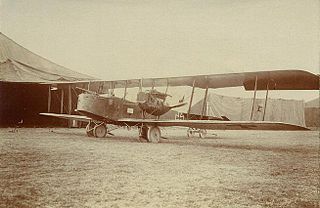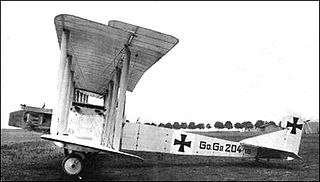| Gotha G.X | |
|---|---|
 | |
| Role | Bomber |
| National origin | Germany |
| Designer | Hans Burkhard |
| First flight | 1918 |
| Number built | 2 |
The Gotha G.X was an experimental bomber aircraft designed and built in Germany from 1917.
| Gotha G.X | |
|---|---|
 | |
| Role | Bomber |
| National origin | Germany |
| Designer | Hans Burkhard |
| First flight | 1918 |
| Number built | 2 |
The Gotha G.X was an experimental bomber aircraft designed and built in Germany from 1917.
The Gotha G.X was an experimental bomber with a general arrangement similar to the Gotha G.V. This relatively small aircraft was powered by two 180 hp B.M.W. IIIa engines and had two-bay wings with auxiliary struts outboard of the engine nacelles.
Aircraft of comparable role, configuration, and era
Related lists

Heavy bombers are bomber aircraft capable of delivering the largest payload of air-to-ground weaponry and longest range of their era. Archetypal heavy bombers have therefore usually been among the largest and most powerful military aircraft at any point in time. In the second half of the 20th century, heavy bombers were largely superseded by strategic bombers, which were often even larger in size, had much longer ranges and were capable of delivering nuclear bombs.

The Henschel Hs 132 was a World War II dive bomber and interceptor aircraft of the German Luftwaffe that never saw service. The unorthodox design featured a top-mounted BMW 003 jet engine and the pilot in a prone position. The Soviet Army occupied the factory just as the Hs 132 V1 was nearing flight testing, the V2 and V3 being 80% and 75% completed.
This is a list of aviation-related events from 1917.

The Gotha G.I was a heavy bomber used by the Luftstreitkräfte during World War I.

The AEG G.II was a German biplane bomber aircraft of World War I developed from the AEG G.I, with more powerful engines. The G.II was typically armed with three 7.92 mm (.312 in) machine guns and 200 kg (440 lb) of bombs. The bomber suffered stability problems, and many G.IIs were fitted with additional vertical tail surfaces on each side of the fin and rudder to improve flight handling characteristics.

The AEG G.IV was a biplane bomber aircraft used in World War I by Germany. It was developed from the AEG G.III, with refinements to power, bomb-load and dimensions. Coming into service in late 1916, it featured a bomb capacity twice as large as that of the AEG G.II, but was still considered inadequate in terms of offensive capacity and performance. Further improvements led to the development of the G.V, but the Armistice came before the replacement could become operational. Serving late in the war, the AEG G.IV managed to achieve some operational success in reconnaissance and combat roles.

The AEG G.V was a biplane bomber aircraft of World War I, a further refinement of the AEG G.IV. The type saw limited production before the Armistice, and never entered operational service. It featured a 600 kg (1,320 lb) bombload.

The Zeppelin-Staaken R.VI was a four-engined German biplane strategic bomber of World War I, and the only Riesenflugzeug design built in any quantity.

The Friedrichshafen G.III was a heavy bomber designed and manufactured by Flugzeugbau Friedrichshafen. They were used by the German Imperial Air Service during World War I for tactical and limited strategic bombing operations. After the end of the war a number of Friedrichshafen bombers were converted into transport aircraft while a small number also saw service as dedicated airliners.

The Mercedes D.IVa was a German six-cylinder, water-cooled, inline engine developed in 1917 for use in aircraft and built by Daimler Motoren Gesellschaft (DMG).

The Friedrichshafen G.IV and G.V respectively were heavy bombers that were designed and manufactured in Germany during World War I by Flugzeugbau Friedrichshafen. The G.IV saw limited use by the Luftstreitkräfte for tactical and limited strategic bombing operations, while the G.V and a follow-on design, the FF.62 did not fly until after the Armistice.

The Gotha G.II series was a heavy bomber used by the Luftstreitkräfte during World War I.

The Gotha G.III was a twin-engine pusher biplane heavy bomber used by the Luftstreitkräfte during World War I. It succeeded the G.II in production and differed primarily in powerplant and in armament details. The G.II's unreliable V-8 Mercedes D.IV was replaced by the new inline six-cylinder 190 kW (250 hp) Mercedes D.IVa engine. The G.III also had a strengthened fuselage with an extra 7.92 mm (0.312 in) machine gun firing through a ventral gun tunnel in the belly to protect the underside of the tail.

The Gotha G.IV was a heavy bomber used by the Luftstreitkräfte during World War I. It was the first mass-produced large airplane.
The Gotha G.VII. a.k.a.GL.VII, was a bomber aircraft produced in Germany during the final months of World War I. With the strategic bombing campaign effectively over, it was intended to be a high-speed tactical bomber with a secondary reconnaissance capability. It was a conventional two-bay biplane design with tractor-mounted engines, and a conventional empennage with twin fins and rudders. The bombardier's position in the nose of the aircraft that had featured on earlier Gotha designs was removed, and the nose of the aircraft severely truncated and fitted with a streamlined nose-cone. This allowed the engines to be located further inboard than on previous designs, bringing them closer to the aircraft's centreline and therefore minimising the effects of asymmetric thrust in the event of an engine failure. The engine nacelles also featured careful streamlining.

The Gotha G.VIII, GL.VIII, G.IX, and G.X were a family of bomber aircraft produced in Germany during the final months of World War I. Based on the Gotha G.VII, they were intended as high-speed tactical bombers featuring advanced streamlining for their day.

The Gotha WD.14, WD.20, and WD.22 were a family of biplane torpedo bomber floatplanes developed in Germany during World War I.
The Gotha G.VI was an experimental bomber aircraft designed and built in Germany during World War I.

The Halberstadt G.I was a German prototype heavy bomber built by Halberstädter Flugzeugwerke during World War I.